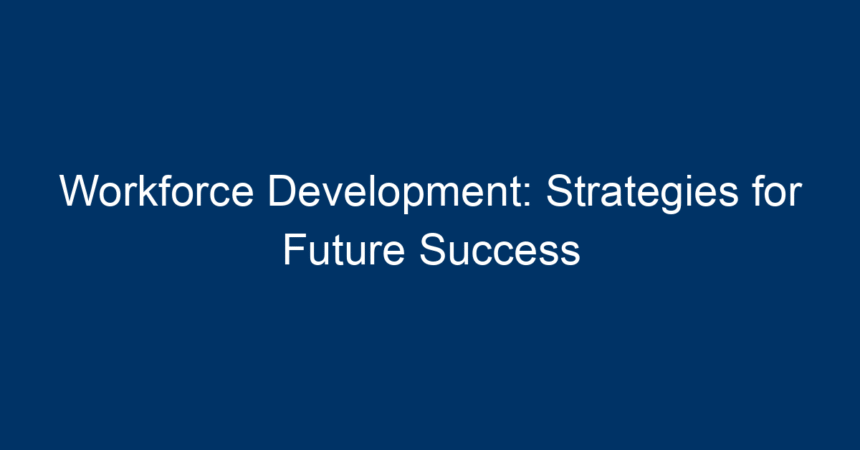In today’s rapidly changing job market, workforce development has emerged as a crucial avenue for creating a skilled, adaptable labor force capable of meeting evolving economic demands. As companies strive for growth and innovation, investing in effective workforce development strategies is imperative. This article will explore various methods for enhancing workforce development, providing actionable insights for businesses, educational institutions, and policymakers.
Understanding Workforce Development
Workforce development refers to the ongoing process of equipping individuals with the skills, training, and education necessary to thrive in the job market. This approach not only benefits employers through a more competent workforce but also aids workers in achieving long-term career success. By embracing workforce development, organizations can foster a culture of continuous learning, which is essential for maintaining a competitive edge.
The Importance of Workforce Development
A well-trained workforce directly contributes to a company’s success. Here are some key reasons why workforce development matters:
- Skill Gaps: Many industries face skills shortages. Workforce development helps bridge these gaps by training potential employees in high-demand skills.
- Employee Retention: Companies that invest in employee training tend to have lower turnover rates, which can reduce recruitment costs and increase morale.
- Innovation: Continuous learning fosters a culture of innovation, allowing organizations to adapt quickly to market changes and improve their products and services.
- Economic Growth: On a macro level, a skilled workforce boosts overall economic productivity, leading to increased GDP and higher living standards.
Key Strategies for Effective Workforce Development
1. Collaborative Partnerships
Collaboration between businesses, educational institutions, and government entities is essential for effective workforce development. Partnerships can maximize resources, align training programs with industry needs, and create opportunities for internships and apprenticeships. For instance, businesses can work with local colleges to create tailored training programs that fulfill the specific skill requirements of the industry.
2. Investing in Training Programs
Investing in comprehensive training programs is crucial for workforce development. Companies should assess their employees’ current skill sets and identify skill gaps. This assessment can guide the implementation of training programs that range from technical skills to soft skills, like communication and leadership. Consider offering both online and in-person training options to maximize accessibility.
3. Emphasizing Lifelong Learning
The concept of lifelong learning encourages employees to continuously develop their skills throughout their careers. Organizations can support this by offering ongoing education opportunities, industry certifications, and workshops. By fostering a commitment to lifelong learning, businesses ensure that their workforce remains competitive and adaptable to industry shifts.
4. Utilizing Technology in Training
Technology plays a significant role in modern workforce development strategies. Online learning platforms, virtual reality simulations, and gamification can make training more engaging and effective. Utilizing data analytics can also help organizations assess training effectiveness and adjust programs according to employee progress and feedback.
5. Encouraging Diversity and Inclusion
A diverse workforce fosters creativity and innovation. Companies should actively pursue strategies that promote diversity and inclusion in their workforce development efforts. This can include tailored recruitment outreach, mentorship programs for underrepresented groups, and ensuring equity in access to training resources.
6. Career Pathways and Advancement Opportunities
To promote workforce development, organizations should create clear career pathways for employees. Transparent advancement opportunities can motivate employees to invest their time and energy into skill development. Regular performance reviews and talent assessment can help identify high potentials and guide them along suitable career trajectories.
Measuring the Impact of Workforce Development
To ensure that workforce development strategies are effective, measuring their impact is critical. Here are key metrics organizations can use:
- Employee Retention Rates: Monitoring how workforce development initiatives influence retention can provide valuable insights.
- Skill Competency Assessments: Regular assessments can help gauge improvements in employees’ skill levels and identify areas that need further attention.
- Productivity Metrics: Comparing productivity rates before and after implementing workforce development strategies can highlight their effectiveness.
- Employee Engagement Surveys: Asking employees about their satisfaction with training programs can reveal what works and what needs improvement.
Overcoming Barriers to Workforce Development
Despite the benefits, several barriers may hinder effective workforce development:
-
Budget Constraints: Limited financial resources can restrict the ability to implement comprehensive training programs. To overcome this, consider leveraging community resources and government grants aimed at workforce development.
-
Lack of Awareness: Many organizations may not fully understand the value of workforce development. Implementing awareness campaigns and sharing success stories can help cultivate a culture that values ongoing training.
- Resistance to Change: Employees may be resistant to new training methodologies or technologies. Open communication about the benefits of training can help mitigate this resistance and encourage buy-in from staff.
Conclusion: Actionable Insights for Workforce Development
As we navigate an era of rapid technological advancement and economic shifts, investing in workforce development is not just a strategic advantage but a necessity. Here are some actionable insights for organizations looking to enhance their workforce development strategies:
-
Establish Collaborative Partnerships: Engage with local educational institutions and government agencies to create tailored training programs.
-
Invest in Comprehensive Training: Conduct regular skills assessments to identify gaps and design diverse training programs.
-
Foster Lifelong Learning: Create an organizational culture that values continuous learning and development.
-
Leverage Technology: Incorporate online platforms and data analytics to enhance training effectiveness.
-
Promote Diversity and Inclusion: Actively seek to diversify your workforce and create equitable opportunities for advancement.
- Measure Impact: Regularly assess the effectiveness of your workforce development initiatives using clear metrics.
By implementing these strategies, organizations can build a robust workforce ready to tackle future challenges, ultimately leading to sustainable growth and success. As we look ahead, the role of workforce development will only continue to expand, underscoring the need for businesses to prioritize this critical area.




